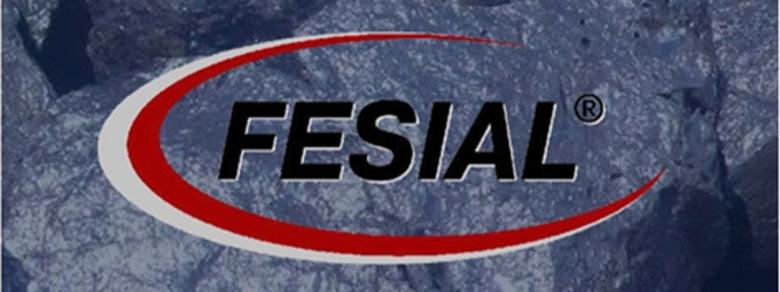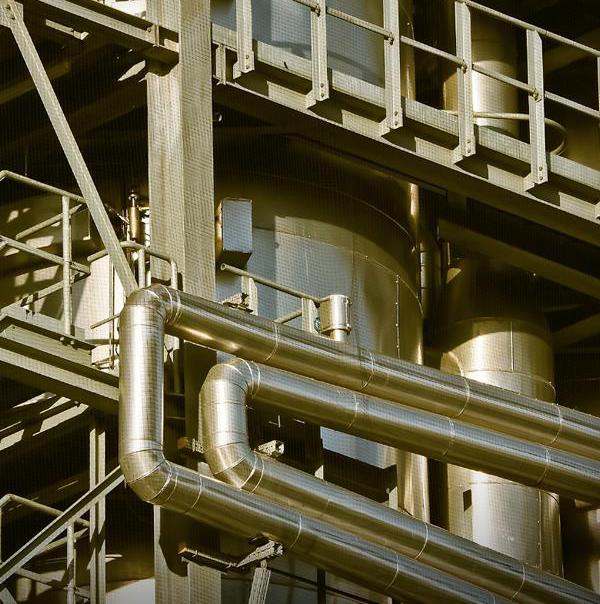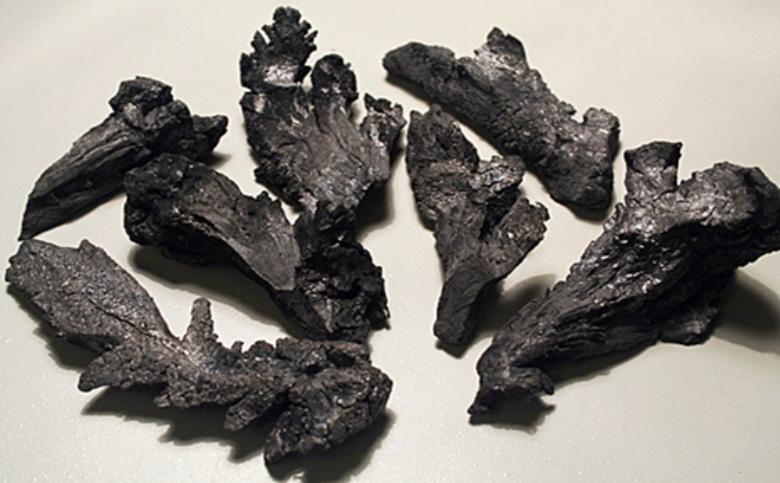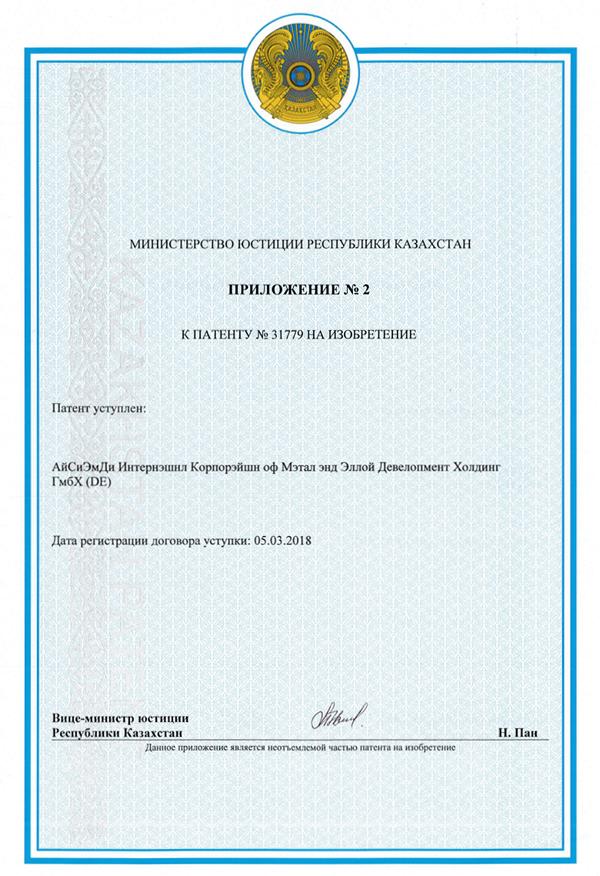
the ferro-silicon-aluminum alloy (FeSiAl).
Traditionally in steel making the melt is deoxidizing by the combined use of secondary aluminum and ferro-silicon. The newly developed Ferro-Silicon-Aluminum combines the metallurgical properties of aluminum as well as ferro-silicon and can therefore be used as substitution product for deoxidation.
The metallurgical benefit of the new alloy has already been tested at several renowned mills and all test results accessible to us proved that the use of standard ferro-silicon could be fully substituted and that the use of aluminum can be considerably reduced by using this alloy.
The technology of ferro-silicon-aluminum smelting from high-ash coal and dump high-ash carbonaceous rocks developed by Kazakhstani scientists has high technical and economic indicators, where the use of expensive coke is completely excluded. The technology is protected by international patents.

Ferro-silicon-aluminum (FeSiAl) alloy represents complex silicon-aluminum alloys. A distinctive feature of the technology of carbothermal production of FeSiAl is the ability to smelt an alloy with a silicon content of 40-70% and aluminum 10-25%.
FeSiAl grades FeSi45Аl10, FeSi45Аl15, FeSi45Аl20 and FeSi55Аl15 successfully replace traditional Ferro-silicon FeSi65 and FeSi75, as well as secondary aluminum of the AB80 and AB85 grades when processing low-grade and low-alloyed steels. If Ferro-silicon does not contain any special harmful impurities except phosphorus, the content of which is limited, the secondary aluminum of the AB80-85 grades contain significant amounts of non-ferrous metal impurities (zinc, lead, copper, etc.) which significantly affect the quality of the steel and refractory lining of electric arc furnaces and ladles.
Numerous industrial tests of FeSiAl in steel processing showed a significant improvement of the quality while reducing the cost of steel production by increasing the beneficial use of silicon and aluminum, in contrast to the traditional scheme of separate deoxidation of steel with ferro-silicon and aluminum.
The increase in the beneficial use of aluminum in the composition of FeSiAl is explained by the presence of intermetallic phases of silicon and iron, as well as iron and aluminum.
When interacting with the steel melt the aluminum in the composition of the FeSiAl is screened from oxidation by silicon, which first begins to interact with iron oxide (FeO), and only after this does the dissolved oxygen interact with the aluminum. Such a mechanism of steel deoxidation when using FeSiAl allows increasing the useful use of aluminum and significantly reducing the frenzy of aluminum. The resulting oxide deoxidation products in the steel volume have a complex composition ([Fe, Mn] O • SiO2, Al2O3), which contributes to their low melting point and easier and complete removal from the steel volume.
A reduction in the amount of residual non-metallic inclusions by 1.5-2 times was achieved in contrast to the traditional deoxidation method. At the same time, residual non-metallic inclusions are characterized by fine dispersion and uniform distribution throughout the steel with favourable morphology.
- thyssenkrupp AG (Germany)
- POSCO (South Korea)
- Çolakoğlu Metalurji A. Ș. (Turkey)
- JFE Steel Corp. (Japan)
- KobeSteelLtd. (Japan)
- "Arcelor Mittal Temirtau" JSC (Republic of Kazakhstan)
- "KazChrome" JSC (Republic of Kazakhstan)
- Omutninsk Metallurgical Plant JSC (Russian Federation)
- Magnitogorsk Eisen- und Stahlwerk JSC (Russian Federation)
After successful testing of the alloy at the metallurgical enterprises in the CIS countries and abroad, agreements were reached on regular deliveries of products after the resumption of FeSiAl production to enterprises: ArcelorMittal Temirtau (Kazakhstan), NLMK, ММК, and ОМК (all - Russia), POSCO Group (South Korea), China Baowu Steel Group (former Baosteel Group Corporation, China). In addition, an off-take agreement was concluded with thyssenkrupp Materials Trading (Germany) and a distribution agreement was signed with the HANWA Group (Japan).

According to the tests results and marketing research thyssenkrupp AG concern (29th place in the world, table 2.14) expressed its opinion on ferro-silicon-aluminum «We hereby confirm that we have the rights to market an innovative alloy of ferro-silicon-aluminum which is in our opinion, a key event in the development of metallurgy”.
Another major application of FeSiAl is its use as a reducing agent for production of refined grades of ferro-chrome and ferro-manganese, as well as in the production of a number of other alloys and master alloys instead of ferrosilicon-chrome and ferrosilicon-manganese with the addition of lime, which contributes to the scattering of the final slags into fine powder during cooling. The use of FeSiAl reduces by 35-40% the addition of lime, 20% power consumption, respectively, the slag ratio from 3.0-4.0 to 1.8-2.5, eliminating the crystallization of two-calcium silicate, thereby, the tendency to slaking.
The use of FeSiAl in the smelting of refined ferro-chrome varieties at the Aktobe ferroalloy plant has shown that it is possible to reduce the cost of production of ferro-chrome by 300-350 USD.
Ferro-silicon-aluminum exhibits a higher deoxidizing ability in comparison to use of ferro-silicon and aluminum. Thus, the replacement of these products with ferro-silicon-aluminum significantly reduces the consumption of raw materials and consequently reduces the cost. Since the modern global steel market is highly consolidated and aimed at improving efficiency, the use of ferro-silicon-aluminum will allow manufacturers to significantly reduce costs and thus increase their profits.
Further positive side effects of using the alloy are expressed in a more thorough decontamination of the smelt from non-metallic inclusions and in improved quality of the steel surface (less cracks).
From the manufacturer’s point of view, ferro-silicon-aluminum is a highly effective product. In addition to the electricity required for the production of all alloys, the production of standard ferro-silicon and aluminum includes the use of several expensive materials (for example quartzite, alumina and reducing agents). In contrast ferro-silicon-aluminum is produced primarily from low-grade coal.
Unlike secondary aluminum there are no non-ferrous metal impurities in the composition of FeSiAl, and the cost per unit of aluminum is 1.5-2 times lower than in pure electrolytic aluminum.
The distinctive feature of the new technology is the use of high-ash carbonaceous raw materials, which is a ready-made natural briquette (mono-mix), where favourable combinations contain compounds of silicon and and solid carbon the amount of which is sufficient for reduction processes and coke addition are not required.
Raw materials costs for smelting FeSiAl are over 50% lower, than those for FeSi75 only due to use of sub-standard raw materials which traditionally go to dumps. And cost of production of FeSiAl is 25 - 35% lower in comparison to cost of production of FeSi75.
The chosen technology for the production of ferro-silicon-aluminum is currently the most effective and beneficial in terms of technology and economics. The basing of technology on the use of high-ash carbonaceous raw materials related to industrial wastes as well as its large reserves open up great prospects for the production of complex silicon-aluminum alloys.
The new technology makes it possible to produce a whole group of complex alloys based on ferro-silicon-aluminum with the addition of alloying elements (vanadium, boron, rare earth metals) and non-metal inclusions modifiers (calcium, barium, strontium).
Kazakhstani researchers have developed and patented an innovative method of manufacturing of pure carboniferous materials from renewable sources. Among vast diversity of wastes of phytogenic materials, a special attention is drawn to rice processing wastes – husk and straw, due to their structural features —high content of silicon dioxide and carbon.
The process was tested in a pilot plant. The new briquetted Silica-Carbon Composite contains (carboniferous product) contains 31-33% SiO2, 53% C and 12% carbohydrates.
The high-purity ferrosilicon with total impurity content under 0,5% was received from this product, with adding of clean quartz sands.
ICMD has acquired this patent in 2018.
The smelting technology of special steel grades (isotropic, anisotropic) is quite difficult. The replacement of charging materials demands industrial tests of the new product in order to investigate its effect on the main structural (crystallographic) and other electro- technical properties of the manufactured steels.
Manufacturing of Ferrosilicon with low Aluminum from the briquetted Silica-Carbon Composite produced during the processing of quartz sands, rice husk and rice straw.
Ferrosilicon is practically free from Al as the raw material does not contain Al. The product of air-tight roasted rice husk with 80% C and 20% SiO2 and wastes of vanadium production with 80% SiO2 and 20% C serve as raw material. Both products do not contain Al. Vanadium is extracted from black-shale deposits in Kazakhstan by sulfuric leaching, in this case the contained Al and Ti are also passing into solution. Therefore, there is no Al in the end product after sulfuric leaching.

Novator GmbH is a subsidiary of HMT Group that develops innovative, environmentally friendly and waste-free coal technologies.
The research group of the Novator project "Special coke with low ash content" succeeded for the first time in 2005 in obtaining the reducing agent - special coke with low ash content from a mineral raw material.
Special coke with low ash content is a deoxidizing agent of the new generation and is used in the melting of crystalline silicon to obtain silicon metal and can thus be used as a 100% charcoal substitute.
The economic and technical advantages over charcoal:
- Power increase of the electric furnace up to 10%
- Reduction of production costs up to 10%
- Increase the degree of extraction from 75% to 93%
- High melt efficiency due to two-component layer (quartz + special coke with low ash content)
The annual output of the special coke is about 10,000 tons.
The applicability of special coke Recsil has been confirmed by scientific research institutes in Kazakhstan and Russia by a large-scale production test.







